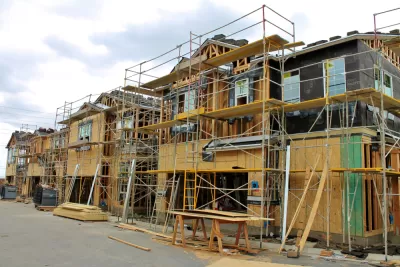A little-known provision in California's state constitution enables exclusionary policies under the guise of local control.

The Los Angeles Times Editorial Board advocates for the repeal of a "racist, classist provision in the state Constitution that makes it harder to build affordable housing." According to the editorial, "Article 34 was adopted in 1950 amid a discriminatory backlash against public housing. It requires that cities get voter approval before they build 'low-rent housing' funded with public dollars."
"Advocates for the repeal have found in polling that voters have a knee-jerk reaction against giving up their right to control what gets built in their community. But the polls have also found that once voters understand the roots of Article 34 and the way it has fueled segregation and inequality, they support the repeal." To that end, "Advocates are struggling to raise the estimated $20 million necessary to run a successful statewide campaign to educate voters on California’s ugly history of housing discrimination."
The board writes that "Supporting the repeal is a way for civic-minded donors, companies and organizations to help right a historical wrong and remove a barrier to building affordable homes for the most vulnerable residents at a time when the state is mired in homelessness."
Born out of racist mid-century fears after the federal Housing Act of 1949 prohibited explicit racial segregation, the board writes, "It’s a remnant of an era that California should repudiate."
FULL STORY: Editorial: A racist relic blocks affordable housing in California. It must go

Alabama: Trump Terminates Settlements for Black Communities Harmed By Raw Sewage
Trump deemed the landmark civil rights agreement “illegal DEI and environmental justice policy.”

Planetizen Federal Action Tracker
A weekly monitor of how Trump’s orders and actions are impacting planners and planning in America.

The 120 Year Old Tiny Home Villages That Sheltered San Francisco’s Earthquake Refugees
More than a century ago, San Francisco mobilized to house thousands of residents displaced by the 1906 earthquake. Could their strategy offer a model for the present?

In Both Crashes and Crime, Public Transportation is Far Safer than Driving
Contrary to popular assumptions, public transportation has far lower crash and crime rates than automobile travel. For safer communities, improve and encourage transit travel.

Report: Zoning Reforms Should Complement Nashville’s Ambitious Transit Plan
Without reform, restrictive zoning codes will limit the impact of the city’s planned transit expansion and could exclude some of the residents who depend on transit the most.

Judge Orders Release of Frozen IRA, IIJA Funding
The decision is a victory for environmental groups who charged that freezing funds for critical infrastructure and disaster response programs caused “real and irreparable harm” to communities.
Urban Design for Planners 1: Software Tools
This six-course series explores essential urban design concepts using open source software and equips planners with the tools they need to participate fully in the urban design process.
Planning for Universal Design
Learn the tools for implementing Universal Design in planning regulations.
Clanton & Associates, Inc.
Jessamine County Fiscal Court
Institute for Housing and Urban Development Studies (IHS)
City of Grandview
Harvard GSD Executive Education
Toledo-Lucas County Plan Commissions
Salt Lake City
NYU Wagner Graduate School of Public Service





























